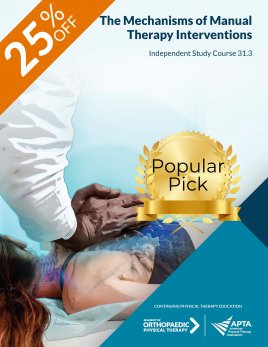
Mechanisms of Manual Therapy Interventions
| Online Only | Online + Hard Copy | |
|---|---|---|
| APTA Orthopedics Member | $75
$56.25
|
$71.25 |
| Non-APTA Orthopedics Member | $225
$168.75
|
$183.75 |
Related Courses
Course Description
This course will provide the clinician with a needed update on the mechanisms of joint-, soft tissue-, and nerve-biased manual therapy interventions. In these monographs, the authors explore the complex interactions between biomechanical and neurophysiological mechanisms of manual therapy techniques. The authors also discuss the importance of establishing a patient’s baseline neurophysiological status – considering both pro-nociceptive and anti-nociceptive mechanisms – which may alter the effects (ie, success versus lack of success) of manual therapy interventions. The non-specific effects of manual therapy are also discussed, including patient factors, provider factors, and provider-patient relationships. Each monograph ends with examples of clinical applications.
Course Overview
Course Format: Online with an option to purchase the print version
Contact Hours: 10 contact hours
State Approval: AOPT courses are accepted in all states plus the District of Columbia, as allowed by the type of course requirements in state regulations. A small number of states require APTA to seek pre-approval of courses. The approval codes for these states can be found here. Always check with your State Licensing Board to confirm contact hours offered.
View Full State Approval InformationCourse Objectives
- Differentiate biomechanical versus neurophysiological effects of manual therapy in individuals with musculoskeletal pain
- Identify interacting mechanisms through which manual therapy may inhibit pain and design interventions accordingly.
- Describe how nociplastic pain presentations may alter manual therapy outcomes.
- Analyze the relationship between dynamic quantitative sensory measures of temporal summation and conditioned pain modulation with neurophysiological mechanisms of wind-up and descending inhibition.
- Compare and contrast the effects of manual therapy versus other physical therapy interventions on opioidergic and non-opioidergic pain inhibitory mechanisms.
- Apply decision making to determine dosage of manual therapy in the patient with and without nociplastic pain.
- Describe considerations for patient improvement after they seek care.
Topics and Authors
- The Mechanisms of Manual Therapy
Joel E. Bialosky, PT, PhD, FAAOMPT, OCS Mark D. Bishop, PT, PhD, FAPTA - Manual Therapy for Chronic Conditions: A Mechanistic Approach to Modern Manual Therapy
Carol A. Courtney, PT, PhD, ATC, FAAOMPT Cesar Fernández-de-las-Peñas, PT, PhD, Dr.MedSci
Customers Frequently Viewed
Add To Cart
Which version of the course would you like to purchase?
Members Only
You need to be a member to buy this course.
Join today to enjoy exclusive deals and prices on all courses.
Join Now